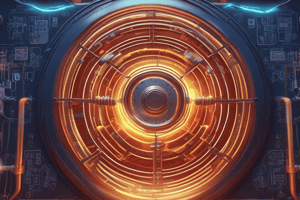Podcast
Questions and Answers
In a star-connected system, what is the relationship between VR, VY, and VB?
In a star-connected system, what is the relationship between VR, VY, and VB?
- VR = VY = VB (correct)
- VR ≠ VY ≠ VB
- VR < VY < VB
- VR > VY > VB
What is the unit of reactive power?
What is the unit of reactive power?
- Watts
- Amps
- Watt-hours
- Volt-Amps (correct)
What is the condition for a single-phase power circuit to be fully resistive in nature?
What is the condition for a single-phase power circuit to be fully resistive in nature?
- φ = 0° (correct)
- φ = 90°
- φ = 180°
- φ = 45°
What is the direction of energy flow in an electrical circuit?
What is the direction of energy flow in an electrical circuit?
What is another name for active power?
What is another name for active power?
What is the formula for reactive power per phase?
What is the formula for reactive power per phase?
What is the range of cos2ωt?
What is the range of cos2ωt?
What is the significance of p being positive?
What is the significance of p being positive?
What is the rate of energy consumption by the load?
What is the rate of energy consumption by the load?
What is the phase angle between voltage and current in a fully resistive circuit?
What is the phase angle between voltage and current in a fully resistive circuit?
Study Notes
Wattmeter and Energy Meter
- A wattmeter is an instrument used to measure electric power given to or developed by an electrical circuit.
- There are two types of wattmeters:
- Electrodynamometer wattmeter (for both DC and AC power measurement)
- Induction wattmeter (for AC power measurement only)
- A wattmeter consists of two coils:
- One coil is connected in series with the circuit (current coil)
- One coil is connected in parallel with the circuit (voltage coil)
Energy Meter
- An energy meter is a device used to measure and record the consumption of electrical energy.
- It is widely used in residential, commercial, and industrial settings to ensure accurate metering of electricity usage.
- An energy meter has four main parts:
- Driving System (electromagnet and copper band)
- Moving System (aluminium disc)
- Braking System (permanent magnet)
- Registering System (counting mechanism)
- The working principle of an energy meter is based on Faraday's law of electromagnetic induction.
- The energy meter measures the power consumption of a load by interacting the magnetic fields of a current coil and a voltage coil.
How an Energy Meter Works
- Current Measurement: The energy meter measures the current flowing through it using a current coil.
- Voltage Measurement: The energy meter measures the voltage using a voltage coil.
- Electric Energy Calculation: The energy meter calculates the power consumption by multiplying the instantaneous voltage and current values.
- Power Calculation: The power consumed by the load is calculated by multiplying the voltage and current values.
- Energy Integration: The energy meter integrates the power over time to calculate the total energy consumption.
- Display and Communication: Modern energy meters have digital displays and communication capabilities to transmit data remotely.
Application of Energy Meters
- Single-phase energy meters are used in residential and small commercial settings.
- Three-phase energy meters are used in industrial and commercial settings with high electrical loads.
- Three-phase energy meters are suitable for measuring energy consumption in factories, power requirements in commercial buildings, and consumption of large machinery and equipment.
Types of 3-Phase Energy Meters
- There are two types of 3-phase energy meters:
- Three phases, three-wire meters (permanent horseshoe magnet)
- Three phases, four-wire meter (three coils and three aluminum discs)
Benefits of Using a 3-Phase Meter
- The ability to use different phases for different rooms.
- The ability to distribute the load.
- Real-time and recorded power consumption data.
- Protection of valuable equipment from high voltage damages.
Analysis of Three-Phase Systems
- A three-phase system consists of three phase conductors and a neutral conductor.
- The sum of the line currents in a 3-phase system is equal to zero.
- The three-phase system has several advantages, including:
- Fewer conductors required compared to single-phase systems.
- Continuous supply to the load.
- Higher efficiency and minimum losses.
- The three-phase system can be connected in two ways:
- Star connection (four wires, including a neutral conductor)
- Delta connection (three wires, no neutral point)### Three-Phase Loads
- A three-phase load can be balanced or unbalanced.
- A balanced load has equal magnitude and phase angle between the three phases.
- In a balanced load, all phase voltages and line voltages are equal in magnitude.
Three-Phase AC Generator
- A three-phase AC generator has three windings, each with two terminals (start and finish).
- Connecting a separate load across each phase winding would require six wires, making the system complicated and costly.
Blondel's Theorem
- Blondel's Theorem is used to determine the type of metering installation needed for a particular service.
- The theorem states that one less element (or CT) is required in a watthour meter than the number of wires in the service to accurately meter the service.
- For a single-phase two-wire service, a watthour meter with one stator (1s meter) is required.
- For a three-phase, three-wire service (delta service), a form 5s meter with two elements is required.
Reactive Power Measurement
- Reactive power (Q) is caused by the phase shift between voltage and current due to inductance and capacitance.
- Reactive power is denoted by Q and expressed in volt-amperes reactive (VAR).
- The formula for reactive power is Q = VI sin Φ.
- Reactive power measurement is essential to determine the nature of the load and measure power factor.
Measurement of Reactive Power in Single-Phase Circuits
- A single-phase varmeter (volt-ampere reactive meter) is used to measure reactive power in single-phase circuits.
- The varmeter has an inductive voltage coil, which causes the current to lag 90° behind the voltage.
- The meter indication is Q = VI sin Φ.
Measurement of Reactive Power in Three-Phase Circuits
- For a three-phase balanced load, the reactive power measured is the same in all phases.
- Only a single wattmeter is required to measure the reactive power.
- The current coil is inserted in one phase, and the voltage coil is connected across the remaining two phases.
Active Power
- Active power is consumed due to the resistive effect of an electrical circuit.
- It is also known as resistive power.
- The active power is always positive, regardless of the instantaneous direction of voltage and current.
- It is the rate of energy consumption by the load.
Studying That Suits You
Use AI to generate personalized quizzes and flashcards to suit your learning preferences.
Description
This quiz covers the construction and theory of operation of wattmeters and energy meters, including types such as electrodynamometer and induction wattmeters.




